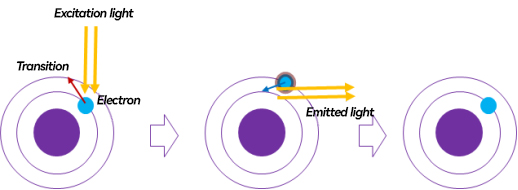Spectrophotometry is a widely used technique in analytical experiments. Cuvettes play a crucial role in laboratory spectral analysis as they are used to hold reference solutions and sample solutions. These cuvettes are compatible with various spectral analysis instruments, making them versatile and essential.

Working Principle of spectrophotometry
In addition to conventional spectrophotometry, fluorescence spectroscopy is also a commonly used detection method. The principle of fluorescence emission is as follows: atoms absorb energy from the light source (excitation light), causing outer electrons to transition from their original orbitals to higher energy levels. When these electrons transition back to lower energy levels, they emit light (emission light) with a different wavelength than the original light. As different substances have different excited energy levels, their emission spectra also differ. At low substance concentrations, the emitted fluorescence intensity is directly proportional to the substance concentration.

Working Principle of Spectrophotometer

Diagram of Fluorescence Generation
To prevent interference, it is common to arrange the light source and fluorescence detector at a 90-degree angle. Therefore, cuvettes that allow light transmission from all four sides are necessary for operation. The most common materials used for cuvettes are glass, quartz glass, and plastic. However, glass and quartz cuvettes often have the following drawbacks:
1. To create a standard curve, the limited cuvettes available in the lab need to be washed at least twice.
2. Washing the cuvettes can potentially affect the measurements of fluorescence intensities due to the fact that fluorescence intensities change over time.
3. Reused cuvettes tend to adsorb dyes from previous experiments, which makes them difficult to clean and can affect experimental results.
4. Glass and quartz cuvettes are both expensive and fragile.
In Comparison, NEST high quality PS Cuvettes excel in the following:

1. The smooth surface is made of high-quality PS material, ensuring there are no bubbles or stripes. This allows for easy observation of the liquid inside.
2. It transmits light in the range of 340-750nm with a transmittance ratio of ≥70%.
3. The cuvette has equally smooth optical surfaces on all four sides, making it suitable for both conventional spectrophotometry and fluorescence spectroscopy.
4. Each cuvette is individually placed in a compartment within a foam case to prevent scratches caused by contact and friction between cuvettes.
5. NEST Cuvettes are affordable and disposable, minimizing the risk of cross-contamination.
To meet the needs of customers with small sample volumes, NEST offers both standard cuvettes and specifically designed semi-micro cuvettes.

For more information or to place an order, please refer to the order information provided below.

